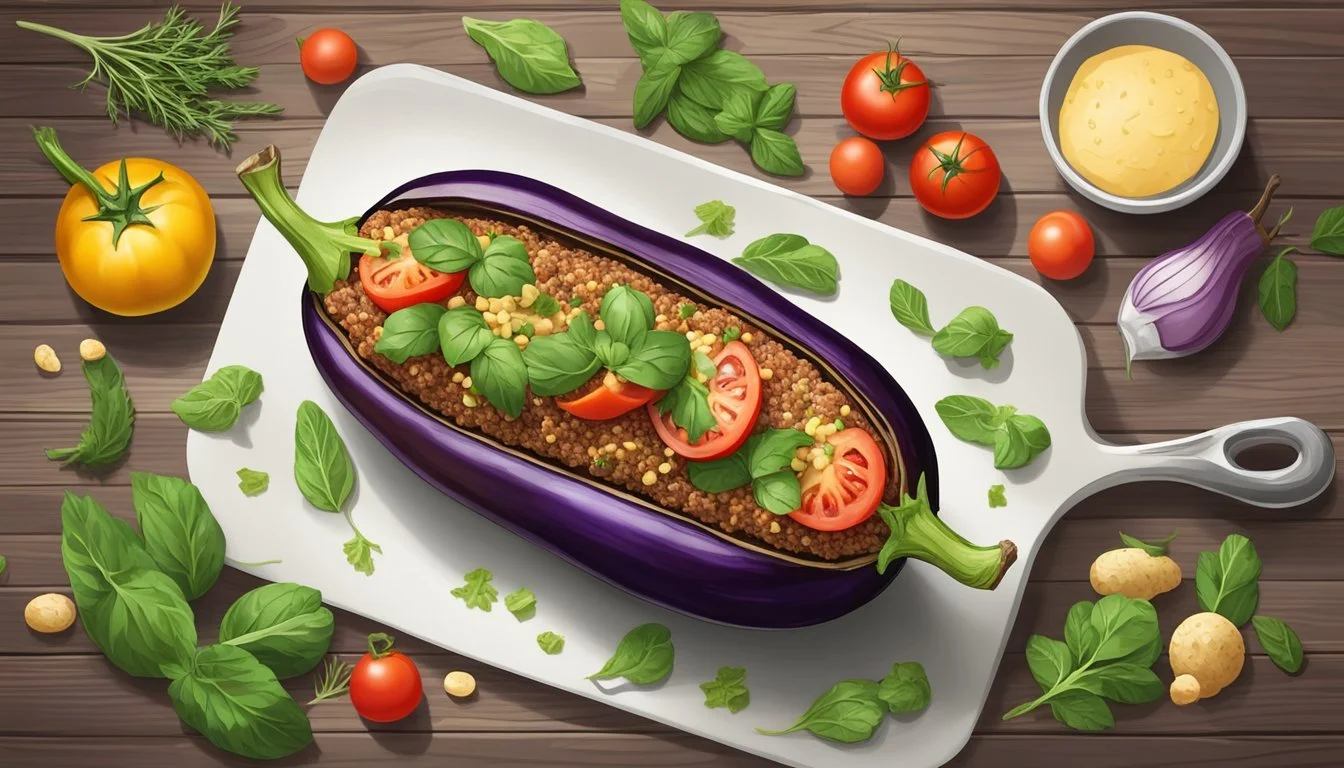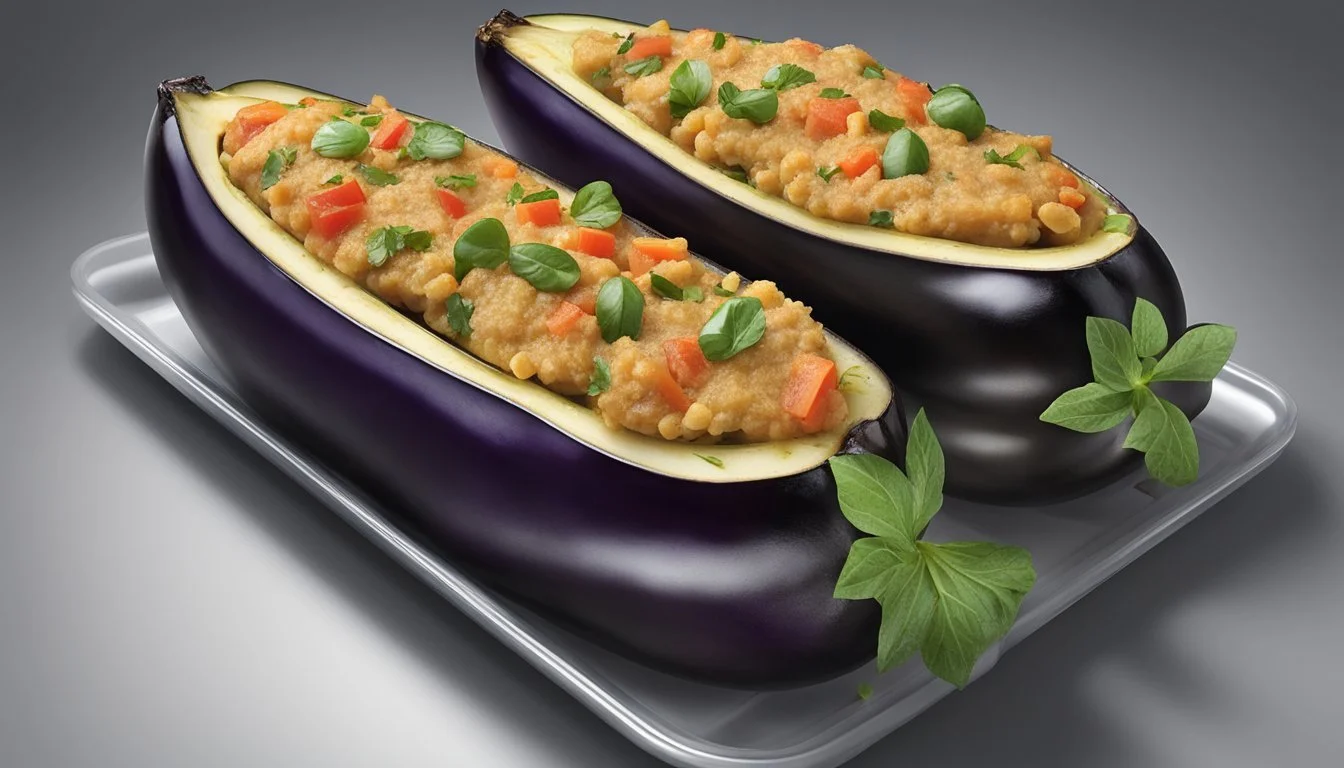How Long Does Gluten-Free Stuffed Eggplant Last?
Storage Tips and Guidelines
When it comes to meal prepping or simply enjoying leftovers, knowing how long gluten-free stuffed eggplant lasts is essential. Properly stored in an airtight container in the refrigerator, gluten-free stuffed eggplant can last up to 3-4 days. This ensures both the flavor and texture remain intact, providing a delicious meal option for several days.
Stuffed eggplant is not only a versatile dish but also a nutritious one, making it an excellent choice for gluten-free diets. The combination of eggplant with a savory filling, such as a mix of vegetables or sausage, topped with cheese, offers a satisfying and hearty meal. For those interested in batch cooking, preparing extra servings can save time and effort throughout the week.
Understanding how to store and handle gluten-free stuffed eggplant properly helps in maintaining its quality. For longer storage, consider freezing the stuffed eggplants. When properly wrapped and frozen, they can last up to 2-3 months. This guarantees that you have a convenient, ready-to-eat meal that's both tasty and safe.
Understanding Gluten-Free Diets
A gluten-free diet involves avoiding foods that contain gluten, a protein found in wheat, barley, and rye. This diet is essential for individuals with celiac disease, as consuming gluten can damage their small intestine lining. Removing gluten from their diet can help manage symptoms and prevent further complications.
People with non-celiac gluten sensitivity might also benefit from avoiding gluten. They experience symptoms similar to celiac disease but without the associated intestinal damage. Adopting a gluten-free diet can relieve these symptoms, such as bloating, fatigue, and headaches.
Benefits of a Gluten-Free Diet
Adopting a gluten-free diet can lead to various health benefits for those with gluten-related disorders:
Improved digestive health
Increased energy levels
Clearer skin
Reduced headaches and brain fog
Foods to Avoid
It is crucial to avoid foods containing gluten. Common foods to exclude are:
Bread, pasta, and cereals made from wheat or barley
Baked goods like cookies, cakes, and pies
Sauces, gravies, and soups thickened with flour
Gluten-Free Alternatives
Many alternatives can replace gluten-containing foods:
Grains: Quinoa, rice, and corn are excellent substitutes.
Flours: Almond flour, coconut flour, and buckwheat flour can be used in baking.
Snacks: Look for gluten-free labeled snacks, such as certain chips and crackers.
It’s essential to read labels carefully since gluten can be present in many processed foods. Look for the "gluten-free" label to ensure products meet safety standards.
Overall, understanding the need for a gluten-free diet and which foods to avoid helps those affected by celiac disease or gluten sensitivity manage their health effectively.
Choosing the Right Ingredients
Using fresh, high-quality ingredients is essential for making gluten-free stuffed eggplant. Key considerations include selecting the best eggplants and deciding between fresh or canned tomatoes, as well as exploring dairy and vegan cheese alternatives.
Selecting Quality Eggplants
Choosing the right eggplant is crucial for a delicious dish. Look for ones that are firm, glossy, and free from blemishes or soft spots. Smaller eggplants tend to be less bitter and have fewer seeds.
To test for freshness, press lightly; a ripe eggplant should give slightly and then bounce back. Also, the stem should be green and fresh-looking, not dried out.
Gluten-Free Filling Options
When selecting gluten-free fillings, think about adding variety and texture. Quinoa, rice, and gluten-free bread crumbs work well as base fillers. Incorporating a mix of mushrooms, peppers, and onions adds flavor and nutrition.
For a heartier filling, ground meats like turkey or beef can be used. It’s essential to ensure all ingredients are certified gluten-free to avoid cross-contamination.
Fresh vs. Canned Tomatoes
Tomatoes form a key ingredient in stuffed eggplant. Fresh tomatoes offer a vibrant and tangy flavor. Look for ripe, firm tomatoes with a deep red color. If using fresh ones, consider Roma tomatoes, known for their low moisture content and rich flavor.
Canned tomatoes are a convenient alternative, providing consistency and saving prep time. Always check for added salts or sugars in canned options to maintain a healthy dish.
Dairy and Vegan Cheese Alternatives
Cheese adds a creamy texture and rich flavor. Traditional options include mozzarella, ricotta, and Parmesan. For a vegan alternative, opt for nut-based cheeses or brands that specialize in vegan cheeses like Daiya or Violife.
Nutritional yeast can also be sprinkled on top to deliver a cheesy flavor without dairy. For an ultra-crispy top, combining gluten-free panko bread crumbs with cheese substitutes works excellently.
By meticulously selecting and preparing each ingredient, you ensure that your gluten-free stuffed eggplant is both flavorful and satisfying.
Preparation Techniques
Proper preparation of gluten-free stuffed eggplant involves several key steps to ensure a flavorful and satisfying dish. Each stage, from prepping the vegetables to combining and stuffing them, plays a crucial role in the final outcome.
Prepping Your Vegetables
Start by washing the eggplants thoroughly under cold water. Slice them lengthwise and carefully scoop out the flesh, leaving a shell about a quarter inch thick. This creates the space needed for stuffing.
Season the eggplant shells with a sprinkling of salt, pepper, and a light brush of olive oil. Placing the shells on a baking sheet covered with parchment paper or baking paper helps to prevent sticking and makes for easy cleanup.
Chop the scooped-out flesh into small, uniform pieces to ensure even cooking. Dice onions, tomatoes, and any other vegetables you plan to include in your stuffing mix. This preparation typically takes about 15-20 minutes.
Mixing the Gluten-Free Filling
In a heated skillet, add some olive oil and sauté the diced onions until they become translucent. Add chopped tomatoes, the reserved eggplant flesh, and other desired vegetables, such as bell peppers or carrots. Season this mixture with a blend of salt, pepper, oregano, and basil.
Stir the vegetables on medium heat until they are tender, which usually takes around 10 minutes. Once cooked, remove the skillet from the heat and allow the mixture to cool slightly. This step ensures that the stuffing doesn't overcook the eggplant shells in the next stage.
Optionally, incorporate gluten-free grains or legumes like quinoa or lentils to add texture and nutrition. Mixing in crumbled feta cheese or parmesan can enhance flavor if dairy is not an issue.
Stuffing and Layering Eggplants
Preheat your oven to 180°C (355°F). Using a spoon, fill each seasoned eggplant shell with the prepared vegetable mixture. Arrange the stuffed eggplants on the same baking sheet used earlier.
Drizzle a bit more olive oil over the stuffed eggplants and scatter fresh basil leaves on top. If desired, pour marinara sauce around the stuffed shells for added moisture and flavor.
Cover the baking sheet with aluminum foil to keep the stuffing moist during baking. Bake for approximately 30 minutes, or until the eggplants are tender. In the last five minutes, you can uncover the foil and sprinkle some additional feta or parmesan cheese to allow it to melt.
After baking, let the stuffed eggplants cool for a few minutes before serving. Properly prepared, they offer a delicious blend of textures and tastes, while adhering to gluten-free dietary needs.
Cooking and Baking
Properly preparing gluten-free stuffed eggplant ensures a delicious and satisfying meal. Key techniques include roasting the eggplants perfectly and using effective gluten-free breading methods to enhance the dish's flavor and texture.
How to Roast Eggplants Perfectly
Roasting eggplants is essential for a tender yet firm texture. Begin by preheating the oven to 400°F (200°C). Cut the eggplants in half lengthwise and scoop out the flesh without damaging the skin, creating "boats." Place the eggplant halves on a baking dish lined with parchment paper to prevent sticking.
Brush the eggplant boats with olive oil and season with salt and black pepper. Roast for about 30 minutes or until the flesh is tender and lightly browned. Ensure even cooking by rotating the baking dish halfway through the cook time. The roasted vegetables should be soft and slightly crispy on the edges, providing a perfect base for the stuffing.
Gluten-Free Breading Techniques
Effective gluten-free breading is crucial for adding texture and flavor. For a classic option, use gluten-free breadcrumbs. Combine them with grated parmesan, garlic powder, and finely chopped fresh herbs like parsley or basil. Coat the eggplant with this mixture before roasting or frying to achieve a crispy crust.
Alternatively, a mixture of almond meal and nutritional yeast can replicate the crunch and umami of traditional breading. To prepare, mix the almond meal with nutritional yeast, salt, and pepper. This combination acts as a vegan and gluten-free "parmesan" crumble. Apply it evenly over the stuffed eggplants before the final bake to ensure a golden, flavorful finish.
Proper application and roasting techniques ensure a delightful gluten-free stuffed eggplant dish with the perfect balance of flavors and textures.
Serving and Presentation
When serving gluten-free stuffed eggplant, presentation and garnishing play a crucial role. Adding fresh herbs and creative plating can elevate the dish to an Instagram-worthy level while also enhancing the flavor.
Garnishing for Aesthetics and Flavor
Garnishing is essential for both visual appeal and added taste. Basil leaves are a classic choice, providing a pop of green and a burst of fresh flavor that complements the eggplant beautifully.
Sprinkle a light dusting of grated parmesan cheese over the top for a rich, salty finish. Add a drizzle of extra virgin olive oil to enhance the dish's richness and give it a subtle shine.
For a touch of color and a hint of spice, consider adding some finely chopped red pepper flakes. This not only improves the visual appeal but also introduces a gentle heat that balances the overall flavor profile.
Plating Your Stuffed Eggplant
Plating is crucial in making your dish stand out. Place the stuffed eggplant halves neatly on each plate. Ensure that the stuffing is visible and facing up to showcase the layers and colors. For an elegant touch, use a white or light-colored plate to make the colors of the dish pop.
Arrange the basil leaves either on top or around the eggplant. This adds a fresh, aromatic element to the plate. Serving the dish with a small bowl of extra marinara sauce on the side caters to those who prefer additional sauce.
Add a few drops of balsamic glaze around the plate for a sophisticated look and a slight sweetness that complements the eggplant. Plating in this manner is ideal for both lunch and dinner, giving a restaurant-quality presentation right at your home.
Storing and Reheating
Proper storage and reheating of gluten-free stuffed eggplants can extend their shelf life and maintain their delicious flavors. Key points to consider include refrigerating leftovers, freezing for extended periods, and reheating for the best quality.
Refrigerating Your Stuffed Eggplants
To refrigerate gluten-free stuffed eggplants, allow them to cool to room temperature after cooking. Place them in an airtight container or wrap each eggplant individually in plastic wrap. Refrigerated stuffed eggplants can last up to 3-4 days. Ensure you place the containers on a shelf rather than in the refrigerator door to maintain a consistent temperature. For best results, store the stuffed eggplants without any liquid sauces, as this prevents the eggplant shells from becoming soggy.
Freezing for Long-Term Storage
Freezing stuffed eggplants ensures they remain fresh for longer durations. First, cool the roasted eggplants completely to avoid ice crystal formation. Wrap each eggplant in aluminum foil and place them in a freezer-safe bag. Label the bags with the date for easy tracking. Frozen stuffed eggplants remain good for up to 3 months. Before reheating, it's advisable to thaw them overnight in the refrigerator. This gentle thawing method helps retain their texture and flavor.
Best Methods to Reheat
For reheating, an oven is typically the best option to evenly warm stuffed eggplants. Preheat the oven to 350°F (175°C). Place the stuffed eggplants on an oven-safe dish, cover with aluminum foil to retain moisture, and bake for 15-25 minutes. Ensure that the internal temperature reaches at least 165°F (74°C). If pressed for time, the microwave can be used by heating on medium power in 1-minute increments, but this may result in a slightly different texture compared to oven reheating.
Nutritional Information
Calories and Macronutrients
A typical serving of gluten-free stuffed eggplant contains about 750 calories. This includes 43 grams of total fat, with 10 grams of saturated fat. There is also a noteworthy amount of monounsaturated fat (25 grams) and polyunsaturated fat (4.8 grams), contributing to its nutrient profile.
Protein and Carbohydrates
Each serving provides a balanced amount of protein and carbohydrates, essential for a vegetarian or plant-based diet. The exact quantities can vary based on the recipe, particularly the filling ingredients like quinoa, rice, or beans which are common in vegetarian versions.
Vitamins and Minerals
Stuffed eggplants are rich in vitamins A and C, primarily from the vegetables used in the filling. They also provide an excellent source of fiber, benefiting digestive health. The inclusion of ingredients such as spinach or tomatoes can significantly boost iron and potassium levels.
Fats and Calories Breakdown
Nutrient Amount Per Serving Total Fat 43g Saturated Fat 10g Trans Fat 0.1g Polyunsaturated Fat 4.8g Monounsaturated Fat 25g Total Calories 750
Considerations for Plant-Based Diets
For those following a vegetarian or plant-based diet, gluten-free stuffed eggplants can be an excellent choice. They provide a complete meal when stuffed with nutrient-dense vegetables, legumes, or grains, ensuring a variety of essential nutrients without the use of meat.
Portion and Serving Size
Portion size is crucial. Ensuring a balanced intake of calories and nutrients can be achieved by modifying the recipe to fit dietary requirements, making it versatile for different dietary needs.
Variations of Stuffed Eggplant
Stuffed eggplant is a versatile dish embraced globally, showcasing cultural diversity and accommodating various dietary needs.
Cultural Takes on Stuffed Eggplant
Different regions have their own unique methods and ingredients for making stuffed eggplant.
Sicilian-Style Stuffed Eggplant is often filled with a mix of Italian sausage, breadcrumbs, tomatoes, and various herbs such as parsley. This version may also use grated Parmesan cheese for an added layer of flavor.
Mediterranean variations might include a stuffing of bulgur or quinoa with vegetables, seasoned with Mediterranean spices like cumin and coriander. These versions focus on fresh, vibrant flavors.
Japanese eggplant offers a more delicate taste and is sometimes stuffed with a miso-based filling, including minced pork or a mix of vegetables, providing an entirely different flavor profile.
Alternatives for Dietary Restrictions
Stuffed eggplant can easily be adapted to meet several dietary restrictions without sacrificing taste or texture.
For a gluten-free version, ingredients such as rice or gluten-free breadcrumbs are commonly used. Gluten-free eggplant Parmesan can be another delicious alternative, layering the stuffed eggplant with gluten-free batter and cheese.
Vegetarian and vegan options often feature a stuffing of lentils, chickpeas, or tofu mixed with various vegetables. This allows for a hearty and satisfying dish while adhering to vegetarian or vegan diets.
Using low-carb mixtures, such as cauliflower rice or finely chopped vegetables, can make the dish suitable for those on keto or low-carb diets, ensuring it remains nutritious and flavorful while fitting into different eating plans.








